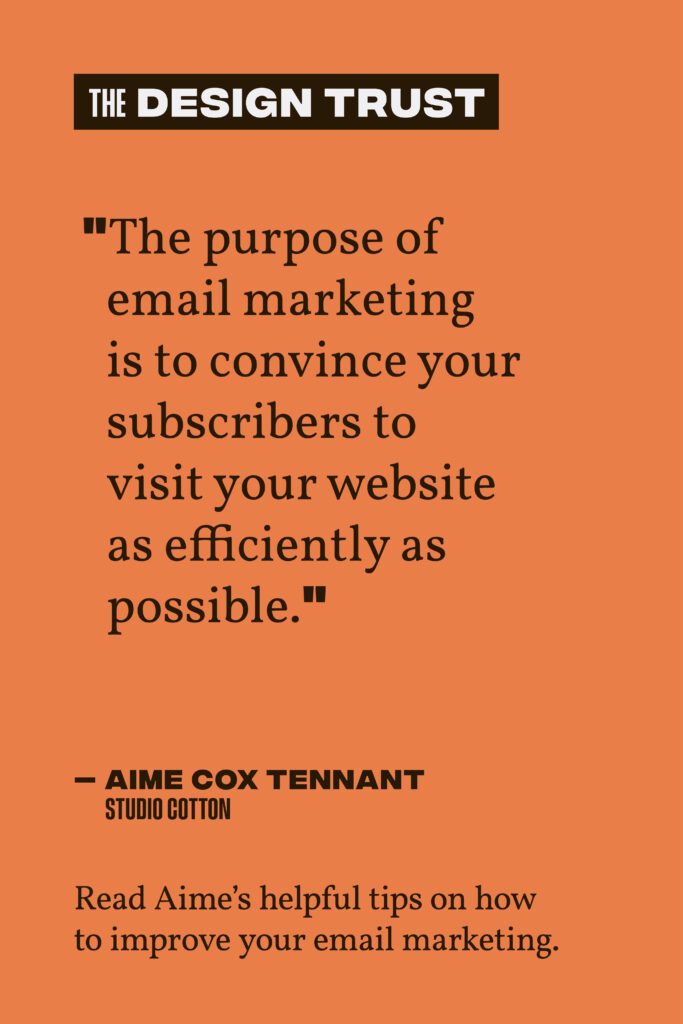Did you know that email marketing is one of your best marketing tools for your creative business? On average, UK businesses make £42 for every £1 invested – which is ludicrously good, and yet, small creative businesses are notoriously neglectful of this powerful and profitable communications tool.
Sure, email marketing can feel ‘old school’ – and you’re right, it’s not got the glamour or the pzazz of Instagram, TikTok or PR – but it has the potential to make you a lot of money for a relatively small amount of work. And it’s often free or has very little cost!
We invited Aime Cox-Tennant, from marketing agency Studio Cotton to share her professional tips for creating better email marketing campaigns for your creative business.
1. Design your marketing emails to match your website
“Our first rule for marketing emails sounds simple, but it’s probably the one that’s most broken by small businesses and creative startups.
Email management tools like MailChimp, MailerLite, ConvertKit, Klaviyo and more, advertise pretty heavy customisation features. You can choose your fonts, colours, dividers, layouts, the shape of your buttons and the width of your borders.
These customisation options can make setting up a new template or campaign quite a fun activity as you experiment with different aesthetics, but I want you to stop.
Brand consistency is crucial for adding value and recognition to your business.
If you’re utilising email marketing – chances are that you already have a website. This means that the way you present your business digitally has already been established.
When you’re setting up a marketing email, follow your website’s lead. If your website has a pink header and a left-aligned logo, your email should have a pink header and a left-aligned logo. If your website has a light blue footer with a 3-pixel dark blue border at the top, so should your marketing emails.
I’ve just made setting up a marketing email a lot more boring, but it will make your communications much more consistent and powerful.”
2. Ditch the welcome waffle
“I am here to crunch all of your email bad habits. And, one of the most important of all: we are ditching the welcome waffle.
Ya know what I mean, the meandering opener that sounds a bit like a postcard from your Aunty Sue enjoying a fortnight in St Ives; “Hey you, hasn’t the weather been crazy? We’ve been exploring beaches, making new friends and working on some secret projects that we can’t wait to share”.
Email introductions are a legacy feature from newsletters, when bygone businesses started distributing their quarterly reports and news bulletins by email in an effort to save money on printing and posting. These same big businesses realised early on that they sold more products and made more money by ditching an unnecessary opening distraction. That is why the welcome waffle feature has been missing for a couple of decades from established eCommerce and service-business marketing emails.
Emails need no introduction. Start your email marketing content with the more important or compelling action that you would like your customer to take, like a big ol’ banner that clicks through to your website.”
3. Use as few words as possible to make your point
“The purpose of email marketing is to convince your subscribers to visit your website as efficiently as possible, so that your website can convert these visits into sales or enquiries.
The last thing we want is for your customers to be hanging out in their email inbox, which is a crowded room filled with messages from both your sales competitors and your attention competitors.
When writing text for your marketing emails, edit, edit and edit again. Ditch your superfluous language, and use your words to sell that click or tap that leads to your website. Too much text not only makes it harder for your reader to absorb your sales message, but it can also give the game away.
Why should someone visit your website, when you give away all the juicy secrets in your email campaign?
It’s a good idea to remember that every minute spent on your website by relevant visitors comes with added search engine optimisation (SEO) benefits too. If your reader stays in their inbox, you don’t get all that lovely clicky data.”

4. Add a clickable link to every picture
“Now here’s a nice easy win: Every image in your marketing email should have a link to a specific page on your website. When we see a picture containing a product or story that we like, most of us would expect to find more detail by clicking or tapping.
Not linking your email pictures is a missed opportunity. Picture-clickers will instead have to search for another opportunity to find the content that has seduced them – or even worse – give up and abandon the journey to your domain.”
5. Be generous with your buttons
“When it comes to navigating through digital environments such as websites and emails, humans are pretty darned predictable. We ruddy love buttons. Just think of the last time you saw a big red button in real life – I bet it was calling out “press me, presssss meeee”.
Well, online buttons are the same. When our brains see a button, it draws us to press, click, or tap it. If you want as many email subscribers as possible to click through to your website, activate that primal button-loving desire with a big bold rectangle.”
6. Include a consistent plan B
“I love shopping the homeware sale at Urban Outfitters. Not full price homewares. Not sale clothing. Just. Sale. Homeware. I subscribe to the Urban Outfitters marketing emails so that I can get the scoop on homeware offers, but that means I still get told about clothing, jewellery and everything else they sell.
But occasionally, I will still open an Urban Outfitters marketing email that has caught my attention – even when it’s clearly not about reduced rattan furniture and delightfully whimsical bathmats. That’s because I know that at the bottom of every single email, I can find a link to their sale section.
The biggest battle in email marketing campaigns is getting the attention of your subscriber. Popping some consistent links in the header and/or footer of your emails means your biggest fans will always have somewhere to click, even if today’s promotion isn’t tickling their fancy.”

7. Never hide your unsubscribe link
“If you remember one thing from this post, I want it to be this: a small and consistent volume of unsubscribes are not bad.
Even the most interesting brands, sharing the most valuable content, to a super clean and engaged mailing list, will get a small percentage of unsubscribes every time they send an email.
It’s impossible to say why each subscriber has had enough, but it shouldn’t be hard to say goodbye. When disengaged individuals leave your mailing list, the overall quality of your email marketing database improves. You now have a higher ratio of interested contacts to uninterested contacts. It will make your stats healthier, and decrease your chances of being marked as an email spammer.
You don’t have to turn your unsubscribe link into one of those cheeky seductive buttons, but do make it clear and easy to find in the footer of your marketing email.
Bonus thing! I think I’m probably more hardcore than most when it comes to ditching the chaff from the wheat in my mailing lists. As a little rule of thumb, if someone hasn’t opened 10 of your marketing emails in a row, they probably don’t want to hear from your business. That’s OK, but you should ditch ‘em.”
8. Sell your email marketing campaigns (not necessarily your offer) with a subject line
There are two factors that determine how likely your subscriber is to open your email: how much they want to hear from you in that moment, and your subject line.
On a campaign-by-campaign basis, there’s not too much we can do to increase how much our subscribers want to hear from us. That job should be the focus for ALL of our marketing, PR, and communications – creating buzz for our brands and a desire for the lifestyle that our products enhance.
We have a little autonomy over the ‘in that moment’ factor. We can time our emails to when our audience is most likely to react to a distraction, and some email management tools will calculate this for us.
One thing we can control the heck out of, is our email subject lines.
A good subject line sells the content of your email campaign.
It’s the eye-catching headline, the piquer of our interest, and the literal definition of click bait. When your email contains a great offer or discount, a literal heading that spells this out is always a great pitch. You can never go wrong with a jolly “Last chance for 20% off”, a super literal “Fancy free delivery?”, or a tantalizing: “Out now! Sally Smith shares her ultimate sales growth secret in Episode 13 of the podcast.”
If your email content is a less overt sales push, try experimenting with mystery-building headlines that draw clicks due in part to their ambiguity. “Your summer style solved.”, “Dream office this way →→→”, “What colour is your personality?”.

Yes! Email marketing campaigns can be really creative, personal and useful for your readers and clients, and be one of your most important and powerful marketing tool for your small creative business. Have a go yourself with these 8 expert tips by Aime Cox-Tennant, from marketing agency Studio Cotton to improve your own email marketing campaigns and let us know how you get on in the comments box below.
Share your questions and comments